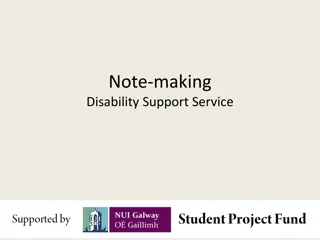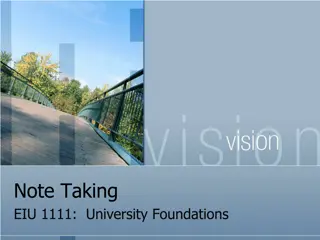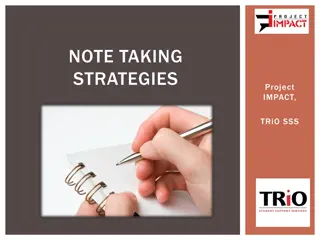Effective Note-Taking Strategies for Academic Success
Explore various note-taking methods discussed by Caroline Havery from UTS, such as annotating texts, creating tables for organized notes, and comparing personal note-taking styles with suggested approaches. Understand the importance of reading in depth and summarizing key points to enhance comprehension and prepare for assessments.
Download Presentation

Please find below an Image/Link to download the presentation.
The content on the website is provided AS IS for your information and personal use only. It may not be sold, licensed, or shared on other websites without obtaining consent from the author.If you encounter any issues during the download, it is possible that the publisher has removed the file from their server.
You are allowed to download the files provided on this website for personal or commercial use, subject to the condition that they are used lawfully. All files are the property of their respective owners.
The content on the website is provided AS IS for your information and personal use only. It may not be sold, licensed, or shared on other websites without obtaining consent from the author.
E N D
Presentation Transcript
Making notes from readings and writing a full reference Week 5 Communication and IT Caroline Havery, UTS, 1
Read the text book section 2.1-2.4 What are the two ways of note taking that are suggested in the book? How do these compare with the way that you take notes? In your school, what options do you have for notetaking? E.g. can you write on a text book or paper copies of readings Do you have electronic copies of text books or readings What kind of notetaking would work best for you? Caroline Havery, UTS, 2
One way of notetaking suggested by the textbook Main Idea My comments/questions Answer to my comments/questions Caroline Havery, UTS, 3
4 Making notes using a table What I am looking for Reading 1 (put the reference) Reading 2 (put the reference) My notes My notes What diarrhoeal disease is How diarrohoeal disease is spread The signs and symptoms of diarrhoeal disease What community members can do in their home to prevent the spread of diarrhoeal disease
Annotate a text Decide what you want to know from the text what are you looking for? Annotate the text as you read Make notes from your annotations At the top of your notes, write down the reference to the text (so when you look back at your notes, you know which text it was) 5
Key point Reading in depth means you can explain the key points of the article to somebody else Writing notes about what you have read will allow to check whether you have understood the reading Caroline Havery, UTS, 6
After class work: make notes on the readings for assessment 1 Make a table in your notebook like the table on slide 4 and begin to make your own notes Remember you need to use your own words when you make notes- you cannot copy exactly from the reading Caroline Havery, UTS, 7
Follow up on after class work: compare your notes Did you make notes on all of the questions in the table? Use your notes to explain to a partner what you have learned about diarrhoeal diseases Caroline Havery, UTS, 8
Referencing correctly Caroline Havery, UTS, 9
Some questions about referencing What is referencing? Why reference? What is plagiarism? What referencing system should I use? Are there general rules for referencing? 10
What is referencing? Acknowledging sources of information or ideas in your assignment .i.e. saying where you got the information from (books, journal and newspaper articles, websites, government documents etc.) You must include a reference to a source if you: Paraphrase (express someone else s idea using your own words) Summarise (express someone else s idea in a reduced form using your own words) Quote (express someone else s idea using their exact words) Copy (reproduce a picture, graph or diagram) 11
Why reference? to show that you have read and understood the research/important information published in your area of study to strengthen or support your argument/explanation to add details, examples, background to your ideas to avoid plagiarism so that you will pass your assignment! 12
How do you reference There are several referencing systems They all achieve the same purpose they just do it in different ways Some use the author date system Some use a number system (the article for Assessment 1 by Seidu et al. 2020 uses a numbering system) 13
What referencing system should you use? You are going to use APA 7th. Here is a quick guide to APA 7thfrom the University of Technology Sydney APA 7th quick guide 14
Two places where references appear in your assignment You need to do both! In text (citation) (Author surname, year of publication) Reference list (at the end of text) You need to provide all of the details of the publication so that another person could find it 15
Activity Look at the reference list for the journal article There are different kinds of references that the article refers to Look at the first 10 references and decide for each one if it is: A book An edited book A journal article Something else Caroline Havery, UTS, 16
Journal article Webpage (organisational author) Journal article Webpage? Or report? Caroline Havery, UTS, 18
Journal article Report (organizational author) Journal article Report (organizational author) Journal article Caroline Havery, UTS, 20
Reference list The reference list goes at the end of your assessment. It is a list of all the things you have used in your assessment List the references in alphabetical order (remember the reference list in the Seidy et al. (2020) is using a different system - it is not APA 7. 21
How to write a full reference in APA 7 style Use the journal article that you are reading for assessment 1. Look at the referencing guide for APA 7 What information do you need to find to write the full reference? In pairs, work out what information you need and then see if you can find it on the article Caroline Havery, UTS, 22
You need Authors Date of Publication Title of article Title of journal Volume and issue number Page numbers Caroline Havery, UTS, 23
Write the information in the correct APA 7 format Use the APA 7 guide to help you write a full reference for the journal article Caroline Havery, UTS, 24
Seidu, A. A., Agbaglo, E., Ahinkorah, B. O., Dadzie, L. K., Bukari, I., Ameyaw, E. K., & Yaya, S. (2020). Individual and contextual factors associated with disposal of children s stools in Papua New Guinea: evidence from the 2016 2018 demographic and health survey. BMC public health, 20, 1-11. Caroline Havery, UTS, 25
You can also use google scholar to help you write the reference You can also use google scholar to help you write the reference Search for the article in google scholar Click on the cite button and select APA Caroline Havery, UTS, 26
After class work After class work Write the full reference for the WHO fact sheet on diarrhoeal disease Caroline Havery, UTS, 29























